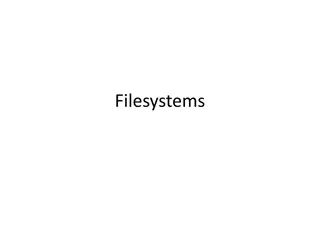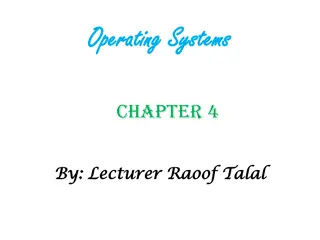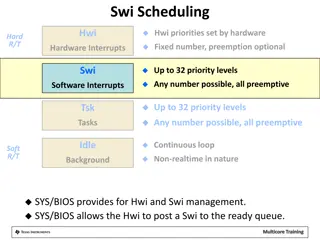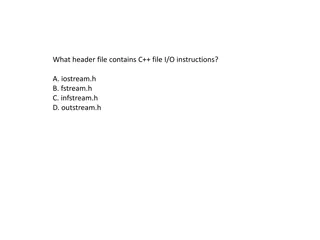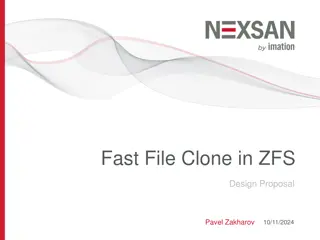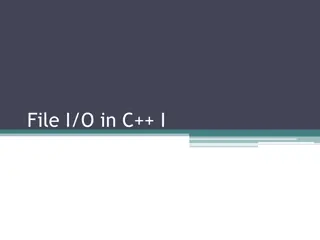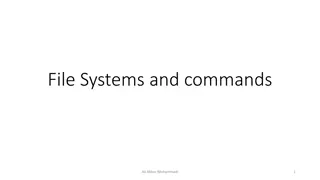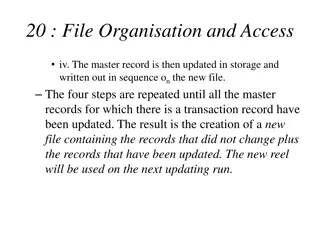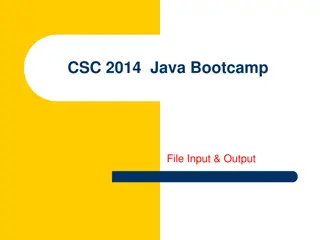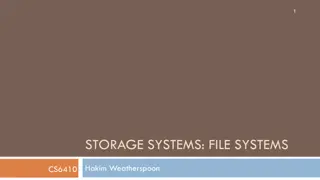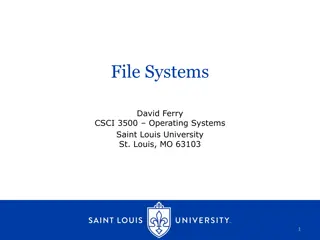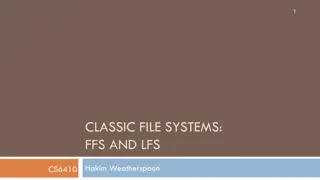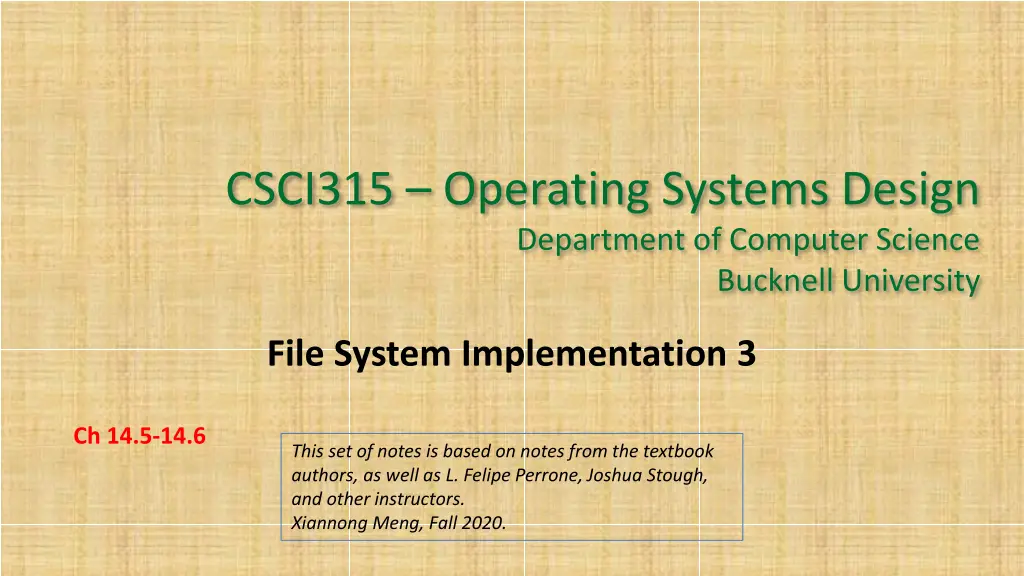
File System Implementation Notes
Explore various methods of file data block allocation, such as contiguous, linked, indexed, and hybrid, along with considerations for performance and free-space management in file systems.
Download Presentation

Please find below an Image/Link to download the presentation.
The content on the website is provided AS IS for your information and personal use only. It may not be sold, licensed, or shared on other websites without obtaining consent from the author. If you encounter any issues during the download, it is possible that the publisher has removed the file from their server.
You are allowed to download the files provided on this website for personal or commercial use, subject to the condition that they are used lawfully. All files are the property of their respective owners.
The content on the website is provided AS IS for your information and personal use only. It may not be sold, licensed, or shared on other websites without obtaining consent from the author.
E N D
Presentation Transcript
CSCI315 Operating Systems Design Department of Computer Science Bucknell University File System Implementation 3 Ch 14.5-14.6 This set of notes is based on notes from the textbook authors, as well as L. Felipe Perrone, Joshua Stough, and other instructors. Xiannong Meng, Fall 2020.
Review We discussed different ways of allocating blocks for file data contiguous allocation in which data blocks for a file are contiguous linked allocation in which the data blocks are chained together, similar to a linked list indexed allocation in which one index block points all data blocks hybrid (or combination) of the above such as what is used in Linux systems.
Performance Best method depends on file access type Contiguous great for sequential and random access Linked good for sequential, not random Declare access type at creation -> select either contiguous or linked Indexed more complex Single block access could require 2 index block reads then data block read Clustering can help improve throughput, reduce CPU overhead
Free-Space Management File system maintains free-space list to track available blocks/clusters (Using term block for simplicity) Bit vector or bit map (n blocks) 0 1 2 n-1 1 block[i] free bit[i] = 0 block[i] occupied Free block number calculation (number of bits per word) * (number of 0-value words) + offset of first 1 bit CPUs have instructions to return offset within word of first 1 bit
Free-Space Management (Cont.) Bit map requires extra space Example: block size = 4KB = 212 bytes disk size = 240 bytes (1 terabyte) n = 240/212 = 228 bits (or 32MB) if clusters of 4 blocks -> 8MB of memory Easy to get contiguous files
Linked Free Space List on Disk Linked list (free list) Cannot get contiguous space easily No waste of space No need to traverse the entire list if # free blocks recorded
Free-Space Management (Cont.) Grouping Modify linked list to store address of next n-1 free blocks in first free block, plus a pointer to next block that contains free-block-pointers Counting Because space is frequently contiguously used and freed, with contiguous-allocation allocation, extents, or clustering Keep address of first free block and count of following free blocks Free space list then has entries containing addresses and counts
Free-Space Management (Cont.) Space Maps Used in ZFS https://en.wikipedia.org/wiki/ZFS Consider meta-data I/O on very large file systems Full data structures like bit maps couldn t fit in memory -> thousands of I/Os Divides device space into meta-slab units and manages meta- slabs Given volume can contain hundreds of meta-slabs Each meta-slab has associated space map Uses counting algorithm But records to log file rather than file system Log of all block activity, in time order, in counting format Meta-slab activity -> load space map into memory in balanced-tree structure, indexed by offset Replay log into that structure Combine contiguous free blocks into single entry
TRIMing Unused Blocks HDDS overwrite in place so need only free list Blocks not treated specially when freed Keeps its data but without any file pointers to it, until overwritten Storage devices not allowing overwrite like NVM (non- volatile memory) suffer badly with same algorithm Must be erased before written, erases made in large chunks (blocks, composed of pages) and are slow TRIM is a newer mechanism for the file system to inform the NVM storage device that a page is free Can be garbage collected or if block is free, now block can be erased https://en.wikipedia.org/wiki/Trim_(computing)
Efficiency and Performance Efficiency dependent on: Disk allocation and directory algorithms Types of data kept in file s directory entry Pre-allocation or as-needed allocation of metadata structures Fixed-size or varying-size data structures
Efficiency and Performance (Cont.) Performance Keeping data and metadata close together Buffer cache separate section of main memory for frequently used blocks Synchronous writes sometimes requested by apps or needed by OS No buffering / caching writes must hit disk before acknowledgement Asynchronous writes more common, buffer-able, faster Free-behind and read-ahead techniques to optimize sequential access a) free-behind technique - free the memory of a block as soon as the next block is requested b) read-ahead technique - when a block is requested, read and cache several subsequent disk blocks to make use of spatial locality http://www.cs.uni.edu/~fienup/courses/copy-of-operating-systems/lecture-notes/notes98f-17.lwp/odyframe.htm
Page Cache A page cache caches pages rather than disk blocks using virtual memory techniques and addresses Memory-mapped I/O uses a page cache Routine I/O through the file system uses the buffer (disk) cache This leads to the figure on next slide
Unified Buffer Cache A unified buffer cache uses the same page cache to cache both memory-mapped pages and ordinary file system I/O to avoid double caching But which caches get priority, and what replacement algorithms to use?



